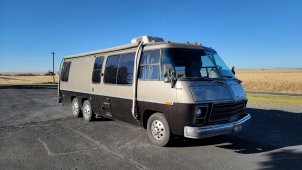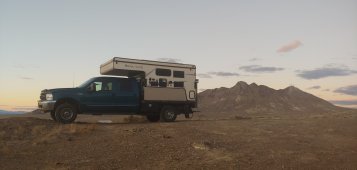kbeefy
New Member
Hi.
I've built 3 simple (successful) solar systems on my camping rigs so far, 100-300 watts, PWM controller and FLA batteries.
FWIW previous builds have been a VW Vanagon, Race car trailer, and cabover camper.
I just bought a small-ish motorhome and am looking to take the next step in 'off-grid' and solar.
I'm planning on 4-600w of glass panels, MPPT controller and 200-400Ah Lifepo4 battery (DIY EVE or chinesium/chins).
I just ordered a 50A Renogy DC-DC charger/MPPT controller.
The MH already has an old Heart Interface 2000w inverter/3 way charger. I know that probably won't be adequate for fully charging the lithium battery but it should bulk charge it for now until I can afford something nicer, and suffice for my minimal AC needs.
The MH is 1978, I don't know the output of the alternator but I'm sure it's pretty low (63-80A?). Even if I upgrade to a higher output alternator the belt would become the limiting factor.
The MH also has a (gas powered) 6kw Onan genset, I am unsure of the DC output available from the Genset.
I am assuming, at this point, that the maximum current to the house batteries with the engine running would be 15-20A. I don't think the GenSet would do any better, unless possibly via AC and a inverter/charger. Not sure if there would be any benefit at that point.
Should I ditch the DC-DC charger? If not, what would the benefit be?
I forsee 110v 3 stage/smart charging and solar being the most beneficial.
I've built 3 simple (successful) solar systems on my camping rigs so far, 100-300 watts, PWM controller and FLA batteries.
FWIW previous builds have been a VW Vanagon, Race car trailer, and cabover camper.
I just bought a small-ish motorhome and am looking to take the next step in 'off-grid' and solar.
I'm planning on 4-600w of glass panels, MPPT controller and 200-400Ah Lifepo4 battery (DIY EVE or chinesium/chins).
I just ordered a 50A Renogy DC-DC charger/MPPT controller.
The MH already has an old Heart Interface 2000w inverter/3 way charger. I know that probably won't be adequate for fully charging the lithium battery but it should bulk charge it for now until I can afford something nicer, and suffice for my minimal AC needs.
The MH is 1978, I don't know the output of the alternator but I'm sure it's pretty low (63-80A?). Even if I upgrade to a higher output alternator the belt would become the limiting factor.
The MH also has a (gas powered) 6kw Onan genset, I am unsure of the DC output available from the Genset.
I am assuming, at this point, that the maximum current to the house batteries with the engine running would be 15-20A. I don't think the GenSet would do any better, unless possibly via AC and a inverter/charger. Not sure if there would be any benefit at that point.
Should I ditch the DC-DC charger? If not, what would the benefit be?
I forsee 110v 3 stage/smart charging and solar being the most beneficial.








